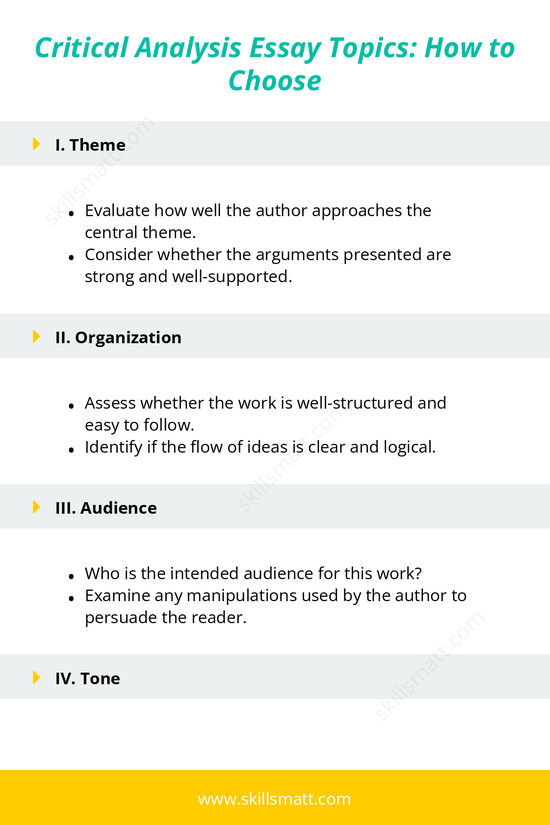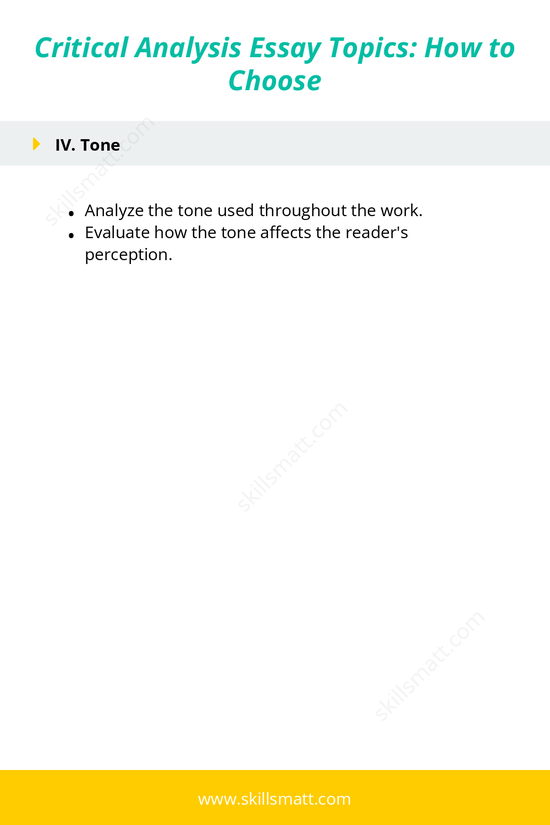Critical Analysis Essay Topics: How to Choose
I. Theme
- Evaluate how well the author approaches the central theme: Assess how effectively the author introduces, develops, and concludes the central theme of the work.
- Consider whether the arguments presented are strong and well-supported: Analyze whether the author’s argument on the theme is logical and backed by solid evidence or examples.
II. Organization
- Assess whether the work is well-structured and easy to follow: Review how the work is organized, paying attention to whether the sections and ideas flow logically from one to another.
- Identify if the flow of ideas is clear and logical: Determine if the work transitions smoothly between points and if the overall structure helps or hinders understanding.
III. Audience
- Who is the intended audience for this work? Analyze who the author is targeting with the work and how well the content speaks to that specific group.
- Examine any manipulations used by the author to persuade the reader: Investigate if the author employs persuasive techniques to sway the audience's opinion.
IV. Tone
- Analyze the tone used throughout the work: Explore whether the author uses a formal, informal, serious, or humorous tone, and why.
- Evaluate how the tone affects the reader’s perception: Consider how the author’s tone shapes the reader’s attitude towards the topic or argument.
V. Bias and Informational Gaps
- Determine if the author considers multiple perspectives: Examine if the work presents a balanced view or if it shows a bias toward one perspective.
- Look for any contradicting arguments or gaps in the information presented: Identify where the author may leave out crucial information or present inconsistent arguments.
VI. Word Choice
- Evaluate the vocabulary used by the author: Consider how the author's word choices contribute to the clarity, tone, or persuasiveness of the argument.
- Consider how the word choice affects the tone and overall writing style: Assess how the author’s selection of language influences the work’s overall impact on the reader.
VII. Logos
- Examine whether the author uses logical reasoning to support their points: Investigate the logical structure of the author’s argument and whether it is coherent.
- Identify the use of facts, statistics, or logical arguments: Look for the inclusion of evidence that supports the author's claims and helps to solidify their arguments.
VIII. Ethos
- Assess the author’s credibility and expertise: Analyze the author’s background and qualifications, and how that contributes to the reliability of the work.
- Look for ways the author builds trust with the reader: Identify how the author establishes authority or credibility through facts, reasoning, or personal experience.
IX. Pathos
- Analyze whether the author appeals to the reader’s emotions: Consider how the author may evoke emotional responses to strengthen their argument or create a connection with the audience.
- Evaluate if the work connects to common beliefs and values: Determine if the work appeals to shared beliefs or societal values to influence the reader’s emotions and perspectives.


